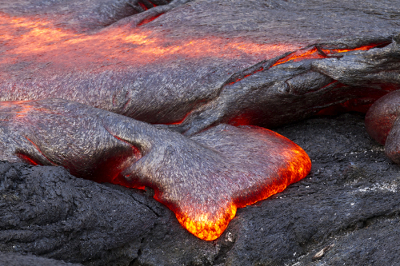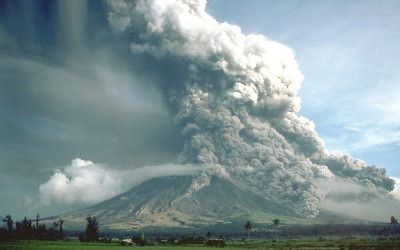火山火成岩
ソース: アラン ・ レスター - コロラド大学ボルダー校講座
火成岩が冷却の製品とマグマの結晶化です。火山岩は、火成岩、マグマ、表面を違反し、冷却と地表環境で結晶化の結果として形成の特定の様々 なです。
マグマ社は、通常範囲の温度約 800 ° C から 1,200 ° C (図 1) で液体の岩です。マグマ自体は、すなわち熱の付加、揮発性物質、および減圧の付加の 3 つの主要な溶解メカニズムを介して地球内で生産されています。融液生成の各モードは、マグマの特定の種類を生成する傾向があるため、異なる噴火様式および構造。

図 1。キラウエア、ハワイの新鮮な溶岩ブレイク アウトします。溶岩は、地球の表面上にあるマグマの用語です。
ホット スポットまたは高温の落水をしばしばリンク熱さらに地殻で溶ける、大陸設定と海洋の設定 (シリカ-貧しい人々) 苦鉄質マグマにおける珪長質 (シリカに富んだ) マグマが生成されます。沈み込み帯融液生成のための最も一般的なメカニズムであり、生成する中間マグマ (中間シリカ豊富)、島弧または線形火山範囲につながる通常揮発性添加 (例では、アリューシャン列島、カスケード山脈 (図 2)、アンデス山脈と)。減圧融解苦鉄質マグマの生成し、地溝帯で発生します。リフティングでき、大陸設定 (例えば東アフリカ地溝帯) でこれを発生してプライマリ溶かす大洋中央海嶺地球を囲み、これらの中、はるかに、私たちの惑星上のマグマ生成の支配的なゾーン (大西洋, 太平洋、インド) の主要な海洋盆地をストレッチするためのメカニズムです。

図 2。3000 フィートの蒸気プルーム 1982 年 5 月 19 日にセントヘ レンズから。
蒸気・ ガス ・火山灰の噴煙しばしば 1980 年代初期にセントヘ レンズ マウントでが発生しました。晴れた日に、彼らが見えた、オレゴン州ポートランドから南へ 50 マイル。ここで撮影した噴煙火山の縁上約 3,000 フィートに昇った。ハリーのリッジ、5 マイル北にある山からの眺めです。
これらの異なる設定で形成されたマグマの種類は、溶融深さ、マントルの融解、受けていると溶解度の組成にリンクされます。
一般に、海洋環境と大陸地溝帯は、アセノス フェア マントル溶融のため玄武岩 (苦) 融液を生成します。
大陸地殻または大陸リソスフェアの割合が高い溶解の結果として通常、珪長質マグマのフォーム海洋リソスフェア、アセノス フェア マントルの融解時に苦鉄質マグマのフォームです。
マグマの粘性と爆発
粘度と揮発性成分は、マグマの爆発のプライマリ コントロールです。揮発性含量の高い粘性の高い珪長質マグマは最も爆発的な噴火を生成する可能性があります。対照的に、高度流体 (低粘度) と低揮発性コンテンツ苦鉄質マグマ (例えば玄武岩) 一般的に生成されます最もバイアスの噴火。
火山噴出物
マグマは火山体から脱出、さまざまな可能な製品、溶岩、火砕岩などがあります。
静止噴火マグマ火山、または亀裂から外側の側面を離れて注ぐことを可能にします。溶岩流と呼びます。溶岩流はほとんど時速数キロを超える速度で旅行します。など、彼らの構造上の損傷の結果しますが、ほとんど生命の損失を引き起こします。
爆発的噴火は、マグマ、岩、火山から噴出するガスの混合物になります。総称して、この放出された物質は「火砕流」と呼ばれる灰からサイズの範囲で生じた火砕物が来ることができる (非常に微細粒材 < 2 mm と超顕微鏡的粒径のしばしば) テフラと爆弾 (2-64 mm)、火山礫に (> 64 mm)。
いくつかのケースで、厚いガス、液滴、ホット フラグメントを含む高流動火砕噴火は動員し、火山の側面を離れて急速な質量と移動します。これらのイベントは、火砕流 (図 3) と呼ばれます。1,000 ° C 程度し、100 から 600 キロ/h の範囲の速度で移動できます。疑いもなく、これらは最も危険な火山噴出物の 1 つです。
火山岩の形成の原則に関連する 2 つの実験を紹介します。最初の実験は、火山層の重要な原則を示して: 溶岩と重ね合わせの原理の後続の成膜。2 番目の実験は頻繁に使用される重曹と酢瓶爆発です。実行する非常に単純ですが、それは火山噴火のいくつかの重要な側面を示しています。
1. CO2火山
- 細い首でプラスチック容器を満たし (16 オンス ソーダ ボトル例えば) 暖かい水で半分くらい。
- 模倣粘土または火山の構造をシミュレートする、公開されているボトルの (オープニング) 首だけを残して、生地の下にボトルを埋めます。
- (泡と泡を生成する可能性が高い液体を作る) するために食器用洗剤を数滴を追加します。
- 漏斗として紙の折り返し部分を使用して、重曹の 4 杯 (約 15-20 mL) を追加します。
- 徐々 にプラスチック製の容器に赤酢を追加します。16 オンス ソーダの瓶を使用している場合は、酢の 8-10 オンスを追加します。それが混ざり始めるまで酢をコンテナーに追加します。
- 必要に応じて、「暴力的な噴火」のコンテナーをコルクまたはより静止噴火の蓋が開いたまま。
2. 溶岩層
- 粘性流体になるのでホット プレート上の暖かいパラフィン。
- 段ボール、薄いセクションを取るし、フォーム ベンドし、様々 な形状の谷で曲げます。傾斜段ボール表面に流動パラフィンを注ぐ。不均一な表面にパラフィンの流れとして本物の溶岩流で見られるだろう、さまざまな厚さの層を形成それ。
- パラフィンが冷却されて固化後は、連続した溶岩流をシミュレートするためにプロセス 2 つまたは 3 回を繰り返します。
火山岩はマグマが表面に違反し、地表環境で立体化するときに形成される火成岩の一種です。その研究は、過去、そしておそらくは将来、火山活動への洞察を提供します。
マグマは地球内制作は、800 から 1,200 ° c の温度に達すると液体のロックマグマの生産の 3 つの主要なメカニズムがある: 熱、揮発性物質、または減圧の付加の付加。融点の異なる各種はマグマの特定の種類を生成、火山噴火の異なるスタイルと構造を生成します。このビデオは、パラフィン ワックスを使用して小規模の溶岩蒸着の種類の違いを示してと CO2を使用して異なる噴火型デモンストレーション。
揮発性含量の高い粘性の高いマグマは、低粘度と低揮発性コンテンツ マグマを表し、一般に生成する最もバイアスの噴火と比較して、最も爆発的な噴火を生成する傾向があります。
静止噴火で溶岩流は側火山のまたは外側の亀裂からをオフします。溶岩流は通常、動きが鈍くなどが生活のほとんどの損失、物的損害の原因します。対照的より爆発的な反応はマグマ、ロック、そしてガス、まとめて「火砕物質」と呼ばれる、火山から排出されるため。
マントル溶融されての種類と、溶解度両方マグマ組成に影響することができます。生産、結果火山と噴火形式の観察結果のマグマ形成に影響します。
一般的に、粘性マグマ社は、組成と大陸地殻または大陸リソスフェアの融解の結果としてフォームでより多く珪長質です。対照的に、低粘性マグマは通常苦鉄質と海洋リソスフェアまたは asthenopheric のマントル溶融の溶解の間に形作る。珪長質および苦鉄質岩については、火成岩のこのコレクションの他のビデオを見る。
火山は、通常、時間をかけて溶岩の連続の証言によって生成されます。粘性の高い溶岩は、成層火山として知られている、背の高い、急な建造物を作成します。対照的に、自由に流れる溶岩が凝固する前にさらに旅、盾状火山と呼ばれる短い、低プロファイルの構造を作成します。
今、我々 は火山噴火、蒸着、マグマの生産の背後にある概念を理解して、どのようにこれらを実験室でシミュレートできますでみましょう。
最初の手順は、静止と爆発的な噴火を示しています。開始、約細い首でプラスチック容器を満たしなさい。 暖かい水の完全な半分。火山の構造をシミュレートするには、模倣粘土またはさらさボトルの首の開口部だけを残して、生地の下にボトルを埋めます。次に、重曹の約 4 杯を追加します。
それが混ざり始めるまでは、ボトルに酢を追加します。色素を含む可視性を助けることができます。静止噴火のボトルをオープンのままにします。激しい噴火のシミュレーションが必要な場合はコルク ボトルです。
静止噴火材料のいくつか流れた溶岩流のような外側。揮発性物質で起訴され、溶岩の流れの泡の性質を彷彿します。
最も火山噴火は、揮発性の損失にリンクされます。特に爆発性のあるものがかなり揮発性放射があります。コルク栓をしたコンテナーの最初の噴火には火山の上空に排出される火砕型材が含まれます。これはまた自然ブロック火山で何が起こるかを示します。
次のデモに関連している溶岩層です。これを示すためには、粘性流体になるまでホット プレート上のパラフィンを温めます。様々 な形状の曲がりと傾斜薄い段ボール表面に流動パラフィンを注ぐ。この様々 なグラデーションは、実際の火山の不均一な表面に溶岩流をシミュレートします。パラフィンは、不均一な表面に流れ、それは実際の火山の表面に見られるだろうものをシミュレートするさまざまな厚さの層を形成します。冷ますために最初のパラフィン層を許可し、同じポイントから始まって、最初に 2 番目の層を注ぐ。連続した溶岩流をシミュレートするために何度もこのプロセスを繰り返します。
どのように層薄膜マグマ供給源からの距離に注意してください。また観察以降ホット レイヤーまたは噴火には基になるレイヤー部分的に溶かすことができます。
レイヤーは、重ね合わせの原理を示します。それ以上の年齢層は、上記成層より最近の噴火堆積物で、下部で発見されます。
さらに、カードの曲がった表面は、ほとんどの火山で見られる凹凸をシミュレートします。各連続噴火と火山の風景を変更する、火山の表面の急または浅い部分にマグマの異なる厚さを収集します。
全体として地質学者および人口の広大なアプリケーションを持って火山岩組成、生成と異なる噴火現象につながる性質を理解すること。
フィールドにおける火山岩の種類を認識し、噴火の特定のスタイルにリンクしては、近くのコミュニティに脅威の種類の地質学者を知らせることができます。この情報には、噴火緊急計画を実装するためのまたは目標とされた安全建設や都市計画を助けることができます。
火山岩の種類は、重要度や過去の噴火の爆発を評価する学ぶことができます。この情報は、土地利用を計画するときに役立ちます。火山堆積は、土壌と農業に影響を与えることができますも積極的に、経済的に有益な深刻な噴火の危険性は低いと考えている場合など場合があります。
火山層は地域の地質学的歴史への窓をすることができます。レイヤーに関する情報を含めることができます過去の気候、環境、生活と容易に日付、地質調査で有用な時間マーカーを提供します。火山は、風光明媚な景観、象徴的なアーサーズ シート、スコットランドのエディンバラ市を一望するを含むを作成することも。これは、石炭紀の時代にさかのぼるし、特別な科学的な興味のサイトが指定されている絶えた火山の最大の残りの部分です。
火山性火成岩のゼウスの概要を見てきただけ。マグマとその堆積のさまざまな種類、静止して爆発的な噴火、そして実験室でまたは家庭でこれらをシミュレートする方法の原理を理解する必要があります今。見てくれてありがとう!見てくれてありがとう!
1. CO2火山
CO2実験中に一部の素材は外側溶岩流のように流れます。揮発性物質で起訴され、溶岩の流れの泡の性質を彷彿します。最も火山噴火は、揮発性の損失にリンクされます。特に爆発性のあるものがかなり揮発性放射があります。最初の噴火でコンテナーをコルク、火山の上空に排出される火砕型材が含まれます。
2. 火山層
火山層実験完了と層薄いマグマ供給源からの距離のことに注意してください。これは、火山によく見られる現象です。後続の層が下位層を溶かすことができる部分的にする場合にも表示することができます。重ね合わせの原理でより古い層は若い層の上に、下に、デモで観察できます。
火山活動と関連岩類の地質学者に注目されています。だけでなくを行う火山噴火ポーズ近くのコミュニティへの脅威、また、風光明媚な景観につながるでき積極的に土壌と農業生産性に影響を与えることを認識することが重要です。
フィールドの火山岩類の認識、噴火の特定のスタイルにリンクおよび過去の活動の領域を把握は、地域の人々 が生活や仕事の根本的な地質学的評価の一部です。火山岩は、過去の噴火活動の指標をすることができます。火山の石の種類は、重大度と過去の噴火の爆発を評価するも使用できます。軽減戦略の開発の重要な部分は、火山地域で発生した噴火 (例えば溶岩流 (図 1)、火山灰、火砕流 (図 3)) の潜在的なタイプを理解すること。

図 3。火砕流は、フィリピン ・ マヨン火山の側面の下 1984 を掃引します。
火山層には地域の「ページ」の歴史にウィンドウことができます。火山層に関する情報を含めることができます過去の気候、環境とも。特に、火山層が比較的簡単に同位体年代測定法を使用して (堆積層) とは異なり、日付です。したがって、火山層は地質調査の時間のマーカー。
スキップ先...
このコレクションのビデオ:

Now Playing
火山火成岩
Earth Science
39.7K 閲覧数

ブラントン コンパス岩層の空間的なオリエンテーションの決定
Earth Science
25.5K 閲覧数

地形図を使用して地形断面を生成するには
Earth Science
32.1K 閲覧数

地質断面図を作る
Earth Science
47.0K 閲覧数

物性 i: 鉱物の結晶と胸の谷間
Earth Science
51.6K 閲覧数

II の鉱物の物理的性質: 組合せ解析
Earth Science
38.0K 閲覧数

火成貫入岩
Earth Science
32.3K 閲覧数

BGDGT 古のバイオ マーカー解析の概要
Earth Science
5.4K 閲覧数

Paleothermometry のアルケノン バイオ マーカー解析の概要
Earth Science
7.2K 閲覧数

底質から脂質バイオ マーカーの超音波抽出
Earth Science
8.8K 閲覧数

堆積物から脂質バイオ マーカーのソックスレー抽出法
Earth Science
18.5K 閲覧数

堆積物中のバイオ マーカーの抽出溶媒抽出を加速
Earth Science
8.9K 閲覧数

U のけん化によって脂肪酸メチルエステルの変換k'37 Paleothermometry
Earth Science
10.1K 閲覧数

カラム ・ クロマトグラフィで総脂質抽出物の精製
Earth Science
12.4K 閲覧数

U の尿素の内転によって分岐、環状化合物の除去k'37 Paleothermometry
Earth Science
6.4K 閲覧数
Copyright © 2023 MyJoVE Corporation. All rights reserved